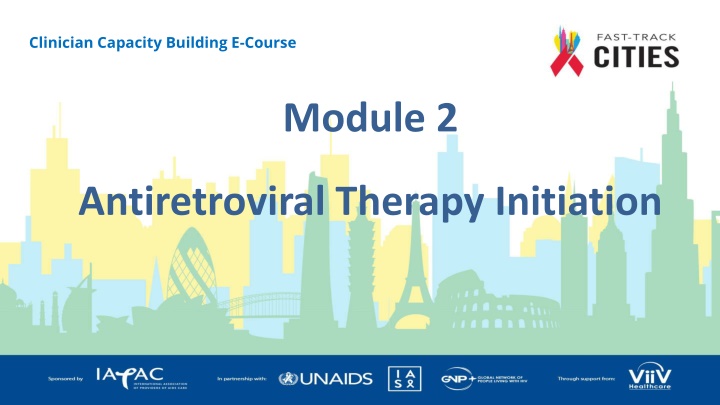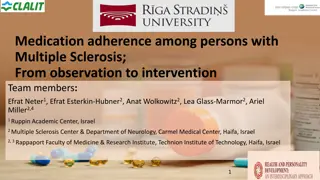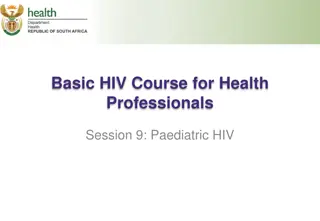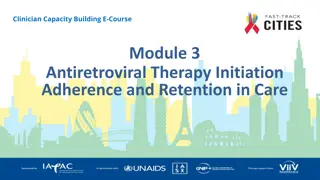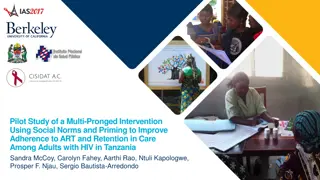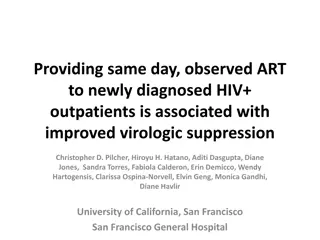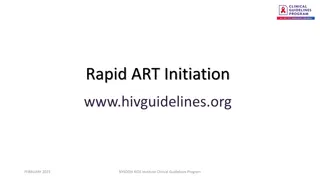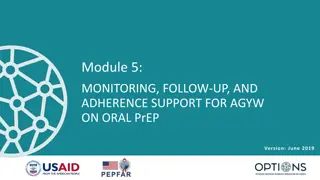Comprehensive Guide to Antiretroviral Therapy Initiation and Adherence
This module provides current recommendations and best practices for initiating antiretroviral therapy (ART), emphasizing treatment benefits, prevention strategies, and maximizing patient outcomes. Learn about the health advantages of ART, including reduced AIDS-related mortality and enhanced quality of life. Discover the preventive benefits of ART in lowering HIV transmission risk, supported by real-world evidence. Gain insights into optimizing ART benefits through timely initiation, adherence interventions, and retention strategies. Explore key considerations such as when to start ART, first-line therapy options, and the importance of treatment initiation. Unlock the potential of ART in transforming the lives of people living with HIV.
Download Presentation

Please find below an Image/Link to download the presentation.
The content on the website is provided AS IS for your information and personal use only. It may not be sold, licensed, or shared on other websites without obtaining consent from the author.If you encounter any issues during the download, it is possible that the publisher has removed the file from their server.
You are allowed to download the files provided on this website for personal or commercial use, subject to the condition that they are used lawfully. All files are the property of their respective owners.
The content on the website is provided AS IS for your information and personal use only. It may not be sold, licensed, or shared on other websites without obtaining consent from the author.
E N D
Presentation Transcript
Clinician Capacity Building E-Course Module 2 Antiretroviral Therapy Initiation
LEARNING OBJECTIVES The purpose of this module is to inform current recommendations and best practices for the initiation of ART, treatment adherence and retention in care After completing this module, you will be able to Explain the treatment and prevention benefits of ART Describe existing recommendations and the latest evidence on initiation of ART Describe how emerging HIV initiation, adherence and retention practices can maximize the proportion of your HIV patients who are virally suppressed
ART substantially improves health and well-being for PLHIV PLHIV can now have a near-normal life span ART has sharply lowered AIDS- related deaths and disability The Health Benefits of Antiretroviral Therapy More than 6-fold decline in deaths in U.S. Continuous ART likely to serve as central HIV treatment strategy for some time Katz IT, et al, Marcus et al, Murray CJL et al. Grinsztejn B et al, Fidler S et al, HIV in the United States: At a Glance, 2018, Atlanta: U.S. Centers for Disease Control and Prevention EMPRANO ANRS 12136 Study Group, INSIGHT START Study Group
Clinical trials have found that ART sharply lowers the risk of HIV transmission Prevention benefits of ART have been confirmed in the real world (Vancouver, KwaZulu-Natal, PEPFAR studies) The Prevention Benefits of Antiretroviral Therapy No linked seroconversion in studies of serodiscordant partners (U=U) Sources: Montaner JS et al., Cohen M et al.. Rodger A et al., Montaner JSG et al., Tanser F et al., PHIA (Population-Based HIV Impact Assessment) Project, Data Summaries, https://phia.icap.columbia.edu/resources/.
Maximizing the Benefits of ART Initiating ART Adherence and retention interventions When to start ART What to use as first-line therapy Dolutegravir and pregnancy Why adherence and retention are important Peer interventions mHealth interventions Patient navigation Data to care Clinic practices
When to Start ART Treatment Guidelines The Importance of the Earliest Possible Treatment Initiation Fast-Tracking Treatment Initiation
Test-and-Treat: Clinical Guidelines ART is recommended for all individuals with HIV, regardless of CD4 count to reduce morbidity and mortality and to prevent new HIV infections NIH, European AIDS Clinical Society, IAS-USA. Australasian Society of HV Medicine Treatment must remain voluntary in all cases counseling and support should be given to patients who are not ready to begin ART Panel on Antiretroviral Guidelines for Adults and Adolescents, Guidelines for the Use of Antiretroviral Agents in Adults and Adolescents Living with HIV, Department of Health and Human Services, 2018, http://aidsinfo.nih.gov/guidelines. Guidelines Version 9.0, 2017, European AIDS Clinical Society. Saag MS et al., Antiretroviral Drugs for Treatment and Prevention of HIV Infection in Adults: 2018 Recommendations of the International Antiviral Society-USA Panel, JAMA 2018;320:379-396. Australasian Society for HIV, Viral Hepatitis and Sexual Health Medicine (ASHM) Sub-Committee for Guidance on HIV Management in Australia
Clinical benefit: educe morbidity and mortality Prevention benefits: Reducing duration of unsuppressed virus Melbourne: Duration of infectiousness among gay men fell five-fold from 49.0 months to 9.6 months 2007-2016 Changes in guidelines and recommendations cited Importance of the Earliest Possible Treatment Initiation Sources: Grinsztejn B et al.. Medland NA et al., TEMPRANO ANRS 12136 Study Group. INSIGHT START Study Group
Fast-Track Treatment Initiation Numerous cities have moved to provide same-day treatment initiation, including Melbourne, New York, San Francisco Same-day treatment initiation is associated with reduced loss to follow-up increased uptake of antiretroviral therapy increased viral suppression improved retention in care Same-day treatment initiation must always be voluntary Sources: Rosen S et al., Amanyire G et al., Pilcher CD et al., Labhardt ND et al Koenig SP et al. Bacon O et al., Stoov M et al., Ending AIDS: Progress towards the 90-90-90 targets, 2018; Geneva: United Nations Program on HIV/AIDS.
Demonstrates the impact of Fast-Track treatment initiation Citywide RAPID program links new HIV diagnoses to care within 5 days treatment initiated at the first visit From 2013 to 2016 reductions in time from diagnosis to care diagnosis to treatment initiation diagnosis to viral suppression Experience in San Francisco and New findings from Melbourne HIV incidence declined average time between diagnoses and undetectable viral load fell Melbourne For information on San Francisco s RAPID program: https://www.gettingtozerosf.org/wp-content/uploads/2016/09/20160822_citywide_rapid_protocol_v2.pdf
Similar results from Western Europe Days from diagnosis to initiation of ART Median & interquartile range EACS 2019 Abstract Book Nov 2019
3-drug regimens What to Start 2-Drug regimens Dolugetravir, Pregnant Women and Children
What to Start Recommended Initial Regimens for Most People DHHS European AIDS Clinical Society Australian Antiretroviral Guidelines follow US DHHS Guidelines with Australian commentary IAS-USA INSTI plus 2 NRTIs BIC/TAF/FTC DTG/ABC/3TC if HLA-B*5701 negative DTG plus (TAF or TDF)a plus (FTC or 3TC) RAL plus (TAF or TDF)a plus (FTC or 3TC) ABC/3TC + DTG ABC/3TC/DTG (Must be HLA-B*57:01 negative and HBsAg negative) Bictegravir/TAF/emtricatabine Dolutegravir/abacavir/lamivudine Dolutegravir plus TAF/emtricitabine TAF/FTC or TDF/FTC or TDF/3TC + DTG INSTI plus 1 NRTI DTG/3TC except for individuals with HIV RNA >500,000 copies/mL, HBV coinfection, or in whom ART is to be started before the results of HIV genotypic resistance testing for reverse transcriptase or HBV testing are available/emtricitabine TAF/FTC/BIC TAF/FTC or TDF/FTC or TDF/3TC + RAL qd or bid Panel on Antiretroviral Guidelines for Adults and Adolescents, Guidelines for the Use of Antiretroviral Agents in Adults and Adolescents Living with HIV, Department of Health and Human Services, July 2019 , http://aidsinfo.nih.gov/guidelines. Guidelines Version 10, Nov 2019, European AIDS Clinical Society. https://eacs.sanfordguide.com/art/initial-regimens-arv-naive-adults Saag MS et al., Antiretroviral Drugs for Treatment and Prevention of HIV Infection in Adults: 2018 Recommendations of the International Antiviral Society-USA Panel, JAMA 2018;320:379-396. HIV Management in Australasia ASHM https://hivmanagement.ashm.org.au/
What to Start Dolutegravir, Pregnant Women and Children DHHS European AIDS Clinical Society Australian Antiretroviral Guidelines follow US DHHS Guidelines with Australian commentary IAS-USA Providers should discuss the benefits of using DTG and the risk of NTDs with the person of childbearing potential, to allow the person to make informed decisions about care. DTG may be used as an alternative ARV for individuals who are of childbearing potential and trying to conceive and those who are sexually active and not using contraception. For individuals who are using effective contraception, DTG may be used as a recommended option Higher risk of neural tube defects if used preconception. Should be switched to another drug All individuals of childbearing age should have documentation of a negative pregnancy test result before starting dolutegravir and should be counseled regarding this potential risk More data are expected it is not yet clear whether other InSTIs pose a similar risk of neural tube defects. Panel on Antiretroviral Guidelines for Adults and Adolescents, Guidelines for the Use of Antiretroviral Agents in Adults and Adolescents Living with HIV, Department of Health and Human Services, July 2019 , http://aidsinfo.nih.gov/guidelines. Guidelines Version 10, Nov 2019, European AIDS Clinical Society. https://eacs.sanfordguide.com/art/initial-regimens-arv-naive-adults Saag MS et al., Antiretroviral Drugs for Treatment and Prevention of HIV Infection in Adults: 2018 Recommendations of the International Antiviral Society-USA Panel, JAMA 2018;320:379-396. HIV Management in Australasia ASHM https://hivmanagement.ashm.org.au/
CAB and RPV intramuscular (IM) injections e used as an optimization strategy for people with HIV currently on oral antiretroviral therapy (ART) with documented viral suppression for at least 3 months who: have no baseline resistance to either medication have no prior virologic failures do not have active hepatitis B virus (HBV) infection (unless also receiving an oral HBV active regimen) are not pregnant and are not planning on becoming pregnant are not receiving medications with significant drug interactions with oral (during lead-in or bridging therapy) or injectable CAB or RPV Source: HHS Adults and Adolescents Antiretroviral Guidelines Panel Recommendation for the Long-Acting Injectable Antiretroviral Regimen of Cabotegravir and Rilpivirine https://clinicalinfo.hiv.gov/sites/default/files/guidelines/documents/AdultARV_GL_ID_2021_CabRpv.pdf Long-Acting Injectable Cabotegravir and Rilpivirine
